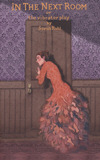In the Next Room or the vibrator play
For fans of Sarah Ruhl’s fanciful often highly theatrical works (Clean House, Eurydice, Melancholy Play) the premise of her latest, Pulitzer Finalist play, In the Next Room or the vibrator play may seem a risky departure from her trademark style. For starters, it is a period piece rooted heavily in historically specific research. At the least, this venture could limit the scope of the timeless, amorphous worlds she often creates and at the worst it could stifle the lyrical beauty that often spills from characters in their theatrically heightened worlds. Fortunately, In the Next Room lacks none of the poetry of Ruhl’s early work.
The play, set circa 1880 at the dawn of electricity, follows Mr. and Mrs. Givings and the events that transpire around Mr. Givings’ patients. Mr. Givings administers therapeutic treatments for men and women diagnosed with hysteria. His preferred method of treatment is stimulation by way of an electric vibrator to release the buildup of troublesome fluids in sensitive areas. At its heart, it is a play about personal revelation and the distances between not only the sexes, but normative and unique experience.
The play’s charm, wit and contemporary social relevance are derived primarily from Ruhl’s exceptional use of dramatic irony. The audience is well aware of the vibrator’s sexual context. However, for Ruhl’s characters, the vibrator is a trip to the doctor, another day at the office, and often laden with the ominous undertones of a very large hypodermic needle. When Mrs. Givings and Mrs. Daldry are trying to figure out how they had such seemingly different experiences from the same treatment, they decided to pose the question to Elizabeth, the wet nurse. After hearing the descriptions, Elizabeth responds:
Those sensations you are describing – they are not from having relations with your husbands?
Mrs. Daldry: Good heavens, no!
Mrs. Givings: No! Good God.
They laugh.
As humorous as these exchanges can be, Ruhl never sells her characters out for the joke. She takes great care to use the sexual dramatic irony to illuminate the differences between her characters’ notions of sex and our contemporary understanding. While the irony is effective and often humorous, it never comes at the sacrifice of the character’s humanity. She even goes so far as to address it in her stage directions for Mrs. Daldry’s first treatment with the vibrator:
She has a quiet paroxysm. Now remember that these are the days before digital pornography. There is no cliché of how women are supposed to orgasm, no idea in their heads of how they are supposed to sound when they climax. Mrs. Daldry’s first orgasms could be very quiet, organic, awkward, primal. Or very clinical. Or embarrassingly natural. But whatever it is, it should not be a cliché, a camp version of how we expect all women sound when they orgasm. It is simply clear that she has had some kind of release.
Ruhl keeps her characters infused with palpable wants and relentless drive. They are all characters struggling to find the locus of their individuality yet desperate to be understood through shared experience. The preferred instrument to forge this connection however, isn’t the magical vibrator but rather poetry and love. When questioning the artist, Leo Irving, who is receiving treatment for a very rare case of male hysteria, Mrs. Givings asks, “Have you loved many women, Mr. Irving?” Leo replies:
I have loved enough to know how to paint. If I had loved fewer, I would be an illustrator; if I had loved more, I would be a poet.
Mrs. Givings: Are poets required to love many women?
Leo: Oh yes. Love animates every line.
In the end, it’s both poetry and love that either brings Ruhl’s characters together or sends them on their separate paths.
Ruhl’s previous plays always made the most out of the theatrical medium. In fact, film adaptations of works like Clean House or Eurydice could easily lose their magic and poetry in translation. However, throughout most of the play, the naturalistic world of In the Next Room would seem to translate well or even benefit from a cinematic adaptation. It may leave certain audience members asking themselves, “Why did this NEED to be a play?” – a question rarely asked when reading Ruhl. Fortunately, in the plays stunning conclusion, the audience is reminded that this is definitely a play, and better yet, this is definitely a Sarah Ruhl play.





